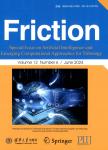Load and velocity boundaries of oil-based superlubricity using 1,3-diketone
作者机构:School of Transportation and Logistics EngineeringWuhan University of TechnologyWuhan 430063China Reliability Engineering InstituteNational Engineering Research Center for Water Transport SafetyMOSTWuhan 430063China Fraunhofer Institute for Mechanics of Materials IWMFreiburg 79108Germany
出 版 物:《Friction》 (摩擦(英文版))
年 卷 期:2023年第11卷第5期
页 面:704-715页
核心收录:
学科分类:081702[工学-化学工艺] 08[工学] 0817[工学-化学工程与技术] 0802[工学-机械工程]
基 金:supported by the National Natural Science Foundation of China(No.51975437) the Sino-German Center for Research Promotion(SGC)(GZ 1576).
主 题:macroscopic superlubricity 1,3-diketone oil running-in process load and velocity boundaries
摘 要:The clarification of the critical operating conditions and the failure mechanism of superlubricity systems is of great significance for seeking appropriate applications in industry.In this work,the superlubricity region of 1,3-diketone oil EPND(1-(4-ethyl phenyl)nonane-1,3-dione)on steel surfaces was identified by performing a series of ball-on-disk rotation friction tests under various normal loads(3.5–64 N)and sliding velocities(100–600 mm/s).The result shows that beyond certain loads or velocities superlubricity failed to be reached due to the following negative effects:(1)Under low load(≤3.5 N),insufficient running-in could not ensure good asperity level conformity between the upper and lower surfaces;(2)the high load(≥64 N)produced excessive wear and big debris;(3)at low velocity(≤100 mm/s),the weak hydrodynamic effect and the generated debris deteriorated the lubrication performance;(4)at high velocity(≥500 mm/s),oil migration occurred and resulted in oil starvation.In order to expand the load and velocity boundaries of the superlubricity region,an optimized running-in method was proposed to avoid the above negative effects.By initially operating a running-in process under a suitable combination of load and velocity(e.g.16 N and 300 mm/s)and then switching to the target certain higher or lower load/velocity(e.g.100 N),the superlubricity region could break through its original boundaries.The result of this work suggests that oil-based superlubricity of 1,3-diketone is a promising solution to friction reduction under suitable operating conditions especially using a well-designed running-in strategy.



